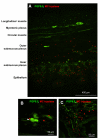Functions and imaging of mast cell and neural axis of the gut
- PMID: 23354018
- PMCID: PMC3922647
- DOI: 10.1053/j.gastro.2013.01.040
Functions and imaging of mast cell and neural axis of the gut
Abstract
Close association between nerves and mast cells in the gut wall provides the microanatomic basis for functional interactions between these elements, supporting the hypothesis that a mast cell-nerve axis influences gut functions in health and disease. Advanced morphology and imaging techniques are now available to assess structural and functional relationships of the mast cell-nerve axis in human gut tissues. Morphologic techniques including co-labeling of mast cells and nerves serve to evaluate changes in their densities and anatomic proximity. Calcium (Ca(++)) and potentiometric dye imaging provide novel insights into functions such as mast cell-nerve signaling in the human gut tissues. Such imaging promises to reveal new ionic or molecular targets to normalize nerve sensitization induced by mast cell hyperactivity or mast cell sensitization by neurogenic inflammatory pathways. These targets include proteinase-activated receptor (PAR) 1 or histamine receptors. In patients, optical imaging in the gut in vivo has the potential to identify neural structures and inflammation in vivo. The latter has some risks and potential of sampling error with a single biopsy. Techniques that image nerve fibers in the retina without the need for contrast agents (optical coherence tomography and full-field optical coherence microscopy) may be applied to study submucous neural plexus. Moreover, the combination of submucosal dissection, use of a fluorescent marker, and endoscopic confocal microscopy provides detailed imaging of myenteric neurons and smooth muscle cells in the muscularis propria. Studies of motility and functional gastrointestinal disorders would be feasible without the need for full-thickness biopsy.
Copyright © 2013 AGA Institute. Published by Elsevier Inc. All rights reserved.
Figures


Similar articles
-
Mast cell-nerve axis with a focus on the human gut.Biochim Biophys Acta. 2012 Jan;1822(1):85-92. doi: 10.1016/j.bbadis.2011.06.004. Epub 2011 Jun 17. Biochim Biophys Acta. 2012. PMID: 21704703 Review.
-
Anatomical variation in mast cell nerve associations in the rat small intestine, heart, lung, and skin. Similarities of distances between neural processes and mast cells, eosinophils, or plasma cells in the jejunal lamina propria.Lab Invest. 1990 May;62(5):626-34. Lab Invest. 1990. PMID: 2342332
-
Mast cell tryptase and proteinase-activated receptor 2 induce hyperexcitability of guinea-pig submucosal neurons.J Physiol. 2003 Mar 1;547(Pt 2):531-42. doi: 10.1113/jphysiol.2002.032011. Epub 2003 Jan 24. J Physiol. 2003. PMID: 12562962 Free PMC article.
-
Evidence for neuronal and structural changes in submucous ganglia of patients with functional dyspepsia.Am J Gastroenterol. 2015 Aug;110(8):1205-15. doi: 10.1038/ajg.2015.158. Epub 2015 Jun 16. Am J Gastroenterol. 2015. PMID: 26077177
-
Imaging of mast cells.Immunol Rev. 2018 Mar;282(1):58-72. doi: 10.1111/imr.12631. Immunol Rev. 2018. PMID: 29431206 Review.
Cited by
-
Role of Macrophages and Mast Cells as Key Players in the Maintenance of Gastrointestinal Smooth Muscle Homeostasis and Disease.Cell Mol Gastroenterol Hepatol. 2022;13(6):1849-1862. doi: 10.1016/j.jcmgh.2022.02.017. Epub 2022 Mar 2. Cell Mol Gastroenterol Hepatol. 2022. PMID: 35245688 Free PMC article. Review.
-
Tranilast increases vasodilator response to acetylcholine in rat mesenteric resistance arteries through increased EDHF participation.PLoS One. 2014 Jul 3;9(7):e100356. doi: 10.1371/journal.pone.0100356. eCollection 2014. PLoS One. 2014. PMID: 24992476 Free PMC article.
-
The immunomodulatory mechanisms for acupuncture practice.Front Immunol. 2023 Apr 6;14:1147718. doi: 10.3389/fimmu.2023.1147718. eCollection 2023. Front Immunol. 2023. PMID: 37090714 Free PMC article. Review.
-
Optical Tools to Investigate Cellular Activity in the Intestinal Wall.J Neurogastroenterol Motil. 2015 Jul 30;21(3):337-51. doi: 10.5056/jnm15096. J Neurogastroenterol Motil. 2015. PMID: 26130630 Free PMC article.
-
Deepening the Mechanisms of Visceral Pain Persistence: An Evaluation of the Gut-Spinal Cord Relationship.Cells. 2020 Jul 24;9(8):1772. doi: 10.3390/cells9081772. Cells. 2020. PMID: 32722246 Free PMC article.
References
-
- Buhner S, Schemann M. Mast cell-nerve axis with a focus on the human gut. Biochim Biophys Acta. 2012;1822:85–92. - PubMed
-
- Bischoff SC. Physiological and pathophysiological functions of intestinal mast cells. Semin Immunopathol. 2009;31:185–205. - PubMed
-
- Lorentz A, Bischoff SC. Regulation of human intestinal mast cells by stem cell factor and IL-4. Immunol Rev. 2001;179:57–60. - PubMed
-
- Aldenborg F, Enerbäck L. The immunohistochemical demonstration of chymase and tryptase in human intestinal mast cells. Histochem J. 1994;26:587–596. - PubMed
Publication types
MeSH terms
Grants and funding
LinkOut - more resources
Full Text Sources
Other Literature Sources
Medical

